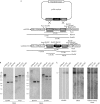A single member of the Plasmodium falciparum var multigene family determines cytoadhesion to the placental receptor chondroitin sulphate A
- PMID: 16025132
- PMCID: PMC1369142
- DOI: 10.1038/sj.embor.7400466
A single member of the Plasmodium falciparum var multigene family determines cytoadhesion to the placental receptor chondroitin sulphate A
Abstract
In high-transmission regions, protective clinical immunity to Plasmodium falciparum develops during the early years of life, limiting serious complications of malaria in young children. Pregnant women are an exception and are especially susceptible to severe P. falciparum infections resulting from the massive adhesion of parasitized erythrocytes to chondroitin sulphate A (CSA) present on placental syncytiotrophoblasts. Epidemiological studies strongly support the feasibility of an intervention strategy to protect pregnant women from disease. However, different parasite molecules have been associated with adhesion to CSA. In this work, we show that disruption of the var2csa gene of P. falciparum results in the inability of parasites to recover the CSA-binding phenotype. This gene is a member of the var multigene family and was previously shown to be composed of domains that mediate binding to CSA. Our results show the central role of var2CSA in CSA adhesion and support var2CSA as a leading vaccine candidate aimed at protecting pregnant women and their fetuses.
Figures



Similar articles
-
Selective upregulation of a single distinctly structured var gene in chondroitin sulphate A-adhering Plasmodium falciparum involved in pregnancy-associated malaria.Mol Microbiol. 2003 Jul;49(1):179-91. doi: 10.1046/j.1365-2958.2003.03570.x. Mol Microbiol. 2003. PMID: 12823820
-
Characterization of VAR2CSA-deficient Plasmodium falciparum-infected erythrocytes selected for adhesion to the BeWo placental cell line.Malar J. 2008 Mar 26;7:51. doi: 10.1186/1475-2875-7-51. Malar J. 2008. PMID: 18364051 Free PMC article.
-
Chondroitin sulphate A (CSA)-binding of single recombinant Duffy-binding-like domains is not restricted to Plasmodium falciparum Erythrocyte Membrane Protein 1 expressed by CSA-binding parasites.Int J Parasitol. 2009 Sep;39(11):1195-204. doi: 10.1016/j.ijpara.2009.02.022. Epub 2009 Mar 24. Int J Parasitol. 2009. PMID: 19324047
-
The role of Plasmodium falciparum var genes in malaria in pregnancy.Mol Microbiol. 2004 Aug;53(4):1011-9. doi: 10.1111/j.1365-2958.2004.04256.x. Mol Microbiol. 2004. PMID: 15306007 Free PMC article. Review.
-
Pregnancy-associated malaria: parasite binding, natural immunity and vaccine development.Int J Parasitol. 2007 Mar;37(3-4):273-83. doi: 10.1016/j.ijpara.2006.11.011. Epub 2006 Dec 22. Int J Parasitol. 2007. PMID: 17224156 Review.
Cited by
-
Assessing the burden of pregnancy-associated malaria under changing transmission settings.Malar J. 2009 Oct 28;8:245. doi: 10.1186/1475-2875-8-245. Malar J. 2009. PMID: 19863792 Free PMC article.
-
Alterations in local chromatin environment are involved in silencing and activation of subtelomeric var genes in Plasmodium falciparum.Mol Microbiol. 2007 Oct;66(1):139-50. doi: 10.1111/j.1365-2958.2007.05899.x. Epub 2007 Aug 28. Mol Microbiol. 2007. PMID: 17725559 Free PMC article.
-
Afucosylated Plasmodium falciparum-specific IgG is induced by infection but not by subunit vaccination.Nat Commun. 2021 Oct 5;12(1):5838. doi: 10.1038/s41467-021-26118-w. Nat Commun. 2021. PMID: 34611164 Free PMC article.
-
How specific is Plasmodium falciparum adherence to chondroitin 4-sulfate?Trends Parasitol. 2011 Sep;27(9):375-81. doi: 10.1016/j.pt.2011.03.005. Epub 2011 Apr 18. Trends Parasitol. 2011. PMID: 21507719 Free PMC article.
-
Identification of malaria parasite-infected red blood cell surface aptamers by inertial microfluidic SELEX (I-SELEX).Sci Rep. 2015 Jul 1;5:11347. doi: 10.1038/srep11347. Sci Rep. 2015. PMID: 26126714 Free PMC article.
References
-
- Andrews KT et al. (2003) Recovery of adhesion to chondroitin-4sulphate in Plasmodium falciparum varCSA disruption mutants by antigenically similar PfEMP1 variants. Mol Microbiol 49: 655–669 - PubMed
-
- Baruch DI, Ma XC, Pasloske B, Howard RJ, Miller LH (1999) CD36 peptides that block cytoadherence define the CD36 binding region for Plasmodium falciparum-infected erythrocytes. Blood 94: 2121–2127 - PubMed
Publication types
MeSH terms
Substances
LinkOut - more resources
Full Text Sources

